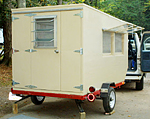What happens if...
7 posts
• Page 1 of 1
What happens if...
what happens if I plug a 8ah or a 16ah battery strait into an automotive cigarette lighter to try and charge it?
-

rlphoto - Teardrop Master
- Posts: 178
- Images: 12
- Joined: Fri Jun 10, 2005 10:37 am
- Location: near Pittsburgh Pa
Would probably work...... Probable not best idea....
Two things may be issue... Current in rush (amperage) to battery from car system may cause accessory socket fuse to blow.. Voltage differential in "charge capacity" may cause battery to charge to fast and cause large gas build up in case and cause excessive pressure and case to split and then you have toxic clean up issues...
A simple 12 volt bulb in series with charge circuit as a current limiter can be a great safety valve to prevent above scenarios... Also it may act as a charge indicator... As bulb gets dimmer it indicates battery is nearing full charge...
Dale
Two things may be issue... Current in rush (amperage) to battery from car system may cause accessory socket fuse to blow.. Voltage differential in "charge capacity" may cause battery to charge to fast and cause large gas build up in case and cause excessive pressure and case to split and then you have toxic clean up issues...
A simple 12 volt bulb in series with charge circuit as a current limiter can be a great safety valve to prevent above scenarios... Also it may act as a charge indicator... As bulb gets dimmer it indicates battery is nearing full charge...
Dale
Lives his life vicariously through his own self.
Any statement made by me are strictly my own opinion.
You are free to ignore anything I say if you do not agree.

Any statement made by me are strictly my own opinion.
You are free to ignore anything I say if you do not agree.

-

Dale M. - 2000 Club

- Posts: 2693
- Images: 18
- Joined: Thu Jun 09, 2005 8:50 pm
- Location: Just a tiny bit west of Yosemite National Park

